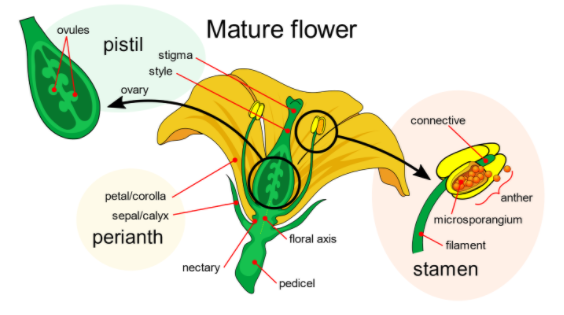Answer
425.1k+ views
Hint: A flower is the reproductive structure found in flowering plants. The biological function of a flower is reproduction. A flower provides an organ which produces egg and sperm and it also provides a platform for the union of sperm with eggs.
Complete answer:.

Flower is the reproductive part and it is found in angiospermic plants. As we already mentioned that the primary function of a flower is reproduction. As the flowers are the reproductive organs of plants, they provide mechanisms for the joining of the sperm or pollen to the ovules. Mainly, the flower has four main parts or whorls—known as the calyx, corolla, androecium, and gynoecium.
A sepal is the outermost part of the flower of angiosperms. Sepals are usually green and the main function of sepal is protection for the flower in bud, and it also supports the petals when a flower blooms. The group or collection of sepals are called the calyx.
The second whorl is petal. Petals are modified leaves which surround the reproductive parts of flowers. The group of the petals are called corolla. Corolla is colourful so that they can attract the insects towards the flower, which brings pollination.
Our third whorl is the stamens of a flower and a group of stamens is known as androecium. A stamen is made up of male reproductive units. A stamen has a long stalk called a filament. At the top of the filament is a cluster of microsporangia called the anther.
The third whorl is the female part of a flower, which is made up of one or more carpels and it's group is known as gynoecium. The gynoecium is the innermost whorl of a flower; it consists of pistils. A pistil typically consists of a swollen basal portion, which we called the ovary, an elongated section called a style and an apical structure that receives pollen called a stigma.
Note: In short, the main 7 parts of the flower are:
Pistil, Petal, stamen, Leaf, Stem, Receptacle and Sepal.
Complete answer:.

Flower is the reproductive part and it is found in angiospermic plants. As we already mentioned that the primary function of a flower is reproduction. As the flowers are the reproductive organs of plants, they provide mechanisms for the joining of the sperm or pollen to the ovules. Mainly, the flower has four main parts or whorls—known as the calyx, corolla, androecium, and gynoecium.
A sepal is the outermost part of the flower of angiosperms. Sepals are usually green and the main function of sepal is protection for the flower in bud, and it also supports the petals when a flower blooms. The group or collection of sepals are called the calyx.
The second whorl is petal. Petals are modified leaves which surround the reproductive parts of flowers. The group of the petals are called corolla. Corolla is colourful so that they can attract the insects towards the flower, which brings pollination.
Our third whorl is the stamens of a flower and a group of stamens is known as androecium. A stamen is made up of male reproductive units. A stamen has a long stalk called a filament. At the top of the filament is a cluster of microsporangia called the anther.
The third whorl is the female part of a flower, which is made up of one or more carpels and it's group is known as gynoecium. The gynoecium is the innermost whorl of a flower; it consists of pistils. A pistil typically consists of a swollen basal portion, which we called the ovary, an elongated section called a style and an apical structure that receives pollen called a stigma.
Note: In short, the main 7 parts of the flower are:
Pistil, Petal, stamen, Leaf, Stem, Receptacle and Sepal.
Recently Updated Pages
How many sigma and pi bonds are present in HCequiv class 11 chemistry CBSE

Why Are Noble Gases NonReactive class 11 chemistry CBSE

Let X and Y be the sets of all positive divisors of class 11 maths CBSE

Let x and y be 2 real numbers which satisfy the equations class 11 maths CBSE

Let x 4log 2sqrt 9k 1 + 7 and y dfrac132log 2sqrt5 class 11 maths CBSE

Let x22ax+b20 and x22bx+a20 be two equations Then the class 11 maths CBSE

Trending doubts
Fill the blanks with the suitable prepositions 1 The class 9 english CBSE

At which age domestication of animals started A Neolithic class 11 social science CBSE

Which are the Top 10 Largest Countries of the World?

Give 10 examples for herbs , shrubs , climbers , creepers

Difference between Prokaryotic cell and Eukaryotic class 11 biology CBSE

Difference Between Plant Cell and Animal Cell

Write a letter to the principal requesting him to grant class 10 english CBSE

Change the following sentences into negative and interrogative class 10 english CBSE

Fill in the blanks A 1 lakh ten thousand B 1 million class 9 maths CBSE



